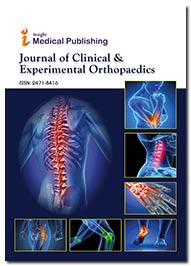Role of Mesenchymal Stem Cells in Cartilage Regeneration for Osteoarthritis Management
Kavita Reddy
Department of Orthopaedics, All India Institute of Medical Sciences, New Delhi, India
Published Date: 2025-02-28DOI10.36648/2471-8416.11.1.317
Kavita Reddy*
Department of Orthopaedics, All India Institute of Medical Sciences, New Delhi, India
Corresponding author:
Kavita Reddy,
Department of Orthopaedics, All India Institute of Medical Sciences, New Delhi, India,
E-mail: kavita.red@asr.in
Received date: February 03, 2025, Manuscript No. ipjceop-25-20801; Editor assigned date: February 05, 2025, PreQC No. ipjceop-25-20801 (PQ); Reviewed date: February 17, 2025, QC No. ipjceop-25-20801; Revised date: February 22, 2025, Manuscript No. ipjceop-25-20801 (R); Published date: February 28, 2025, DOI: 10.36648/2471-8416.11.1.317
Citation: Reddy K (2025) Role of Mesenchymal Stem Cells in Cartilage Regeneration for Osteoarthritis Management. J Clin Exp Orthopr Vol.11 No.1: 317.
Introduction
Osteoarthritis (OA) is the most prevalent degenerative joint disorder, characterized by progressive cartilage breakdown, subchondral bone remodeling, synovial inflammation, and chronic pain. Current management strategies are primarily palliative, focusing on symptom control with analgesics, nonsteroidal anti-inflammatory drugs, intra-articular injections, and physical therapy. However, these approaches fail to address the underlying pathology of cartilage degeneration. In recent years, regenerative medicine has explored cell-based therapies, particularly mesenchymal stem cells, as promising tools for restoring cartilage integrity and function. MSCs are multipotent progenitor cells capable of differentiating into chondrocytes, osteoblasts, and adipocytes. They can be isolated from various tissues, including bone marrow, adipose tissue, synovium, and umbilical cord. Their accessibility, proliferative potential, and immunomodulatory properties make them attractive candidates for OA therapy. Unlike conventional treatments, MSC-based strategies aim to repair or regenerate damaged cartilage rather than simply alleviating symptoms [1].
Description
One of the primary mechanisms by which MSCs contribute to cartilage regeneration is through chondrogenic differentiation. When exposed to appropriate growth factors, such as transforming growth factor-beta, MSCs can differentiate into chondrocytes, producing extracellular matrix components like type II collagen and aggrecan. This capacity provides a biological basis for their therapeutic use in regenerating articular cartilage that is otherwise avascular and has limited self-repair ability. In addition to differentiation, MSCs exert profound paracrine effects by secreting bioactive molecules, cytokines, and extracellular vesicles. These secretions modulate the joint microenvironment by suppressing inflammation, inhibiting catabolic pathways, and stimulating resident chondrocytes. This dual role-direct regeneration and indirect modulation-places MSCs at the center of regenerative approaches for OA [2].
Clinical studies have reported encouraging outcomes following intra-articular injection of MSCs. Patients often experience reduced pain, improved mobility, and enhanced quality of life. Imaging studies, including MRI, have demonstrated increases in cartilage thickness and integrity in some cases. However, results remain heterogeneous, with variability depending on MSC source, dosage, delivery method, and patient selection. The source of MSCs plays a critical role in therapeutic outcomes. Bone marrow-derived MSCs have been the most extensively studied, showing strong chondrogenic potential. Adipose-derived MSCs are easier to harvest and yield higher cell numbers, while synovial-derived MSCs exhibit superior proliferative and chondrogenic capacities. Comparative studies suggest that source-specific characteristics may influence regenerative efficacy and long-term outcomes [3].
One of the challenges in MSC therapy is ensuring cell survival and integration in the harsh joint environment. The degenerative OA joint is characterized by inflammation, oxidative stress, and mechanical stress, all of which impair MSC viability and differentiation. To address this, researchers are exploring biomaterial scaffolds, hydrogels, and tissue engineering constructs that provide structural support and bioactive cues to enhance MSC retention and function [4].
The immunomodulatory properties of MSCs are also highly relevant in OA management. By modulating T-cell responses, inhibiting pro-inflammatory cytokines, and promoting anti-inflammatory pathways, MSCs reduce synovitis and joint inflammation. This immunoregulatory capacity contributes not only to symptom relief but also to slowing the progression of cartilage damage. Despite promising results, limitations and safety concerns persist. Some patients show limited or no response to MSC therapy, and variability in clinical trial design hampers definitive conclusions. Questions remain regarding optimal cell dose, frequency of injections, long-term durability of regenerated cartilage, and potential risks such as abnormal tissue formation. The regulatory landscape also influences the clinical translation of MSC therapies [5].
Conclusion
Mesenchymal stem cells represent a transformative approach in the management of osteoarthritis by offering the potential for cartilage regeneration, modulation of inflammation, and long-term joint preservation. While conventional treatments provide only symptomatic relief, MSC-based therapies address the root cause of cartilage degeneration. However, clinical translation faces challenges related to heterogeneity in outcomes, regulatory standardization, and cost-effectiveness. As research advances in cell biology, tissue engineering, and immunology, MSCs hold promise to shift osteoarthritis management from palliation to true regeneration, ultimately improving outcomes for millions of patients worldwide.
Acknowledgement
None.
Conflict of Interest
None.
References
- Wu J, Wu J, Xiang W, Gong Y, Feng D, et al. (2024). Engineering exosomes derived from TNF-α preconditioned IPFP-MSCs enhance both yield and therapeutic efficacy for osteoarthritis. J Nanobiotechnology22: 555.
Google Scholar Cross Ref Indexed at
- Kim M, Shin DI, Choi BH, Min BH. (2021). Exosomes from IL-1β-primed mesenchymal stem cells inhibited IL-1β-and TNF-α-mediated inflammatory responses in osteoarthritic SW982 cells. Tissue Eng Regen Med 18: 525-536.
Google Scholar Cross Ref Indexed at
- Tao SC, Yuan T, Zhang YL, Yin WJ, Guo SC, et al. (2017). Exosomes derived from miR-140-5p-overexpressing human synovial mesenchymal stem cells enhance cartilage tissue regeneration and prevent osteoarthritis of the knee in a rat model. Theranostics 7: 180.
Google Scholar Cross Ref Indexed at
- Li H, Zheng Q, Xie X, Wang J, Zhu H, et al. (2021). Role of exosomal non-coding RNAs in bone-related diseases. Front Cell Dev Biol9: 811666.
Google Scholar Cross Ref Indexed at
- Tan F, Li X, Wang Z, Li J, Shahzad K, et al. (2024). Clinical applications of stem cell-derived exosomes. Signal Transduct Target Ther9: 17.
Open Access Journals
- Aquaculture & Veterinary Science
- Chemistry & Chemical Sciences
- Clinical Sciences
- Engineering
- General Science
- Genetics & Molecular Biology
- Health Care & Nursing
- Immunology & Microbiology
- Materials Science
- Mathematics & Physics
- Medical Sciences
- Neurology & Psychiatry
- Oncology & Cancer Science
- Pharmaceutical Sciences
